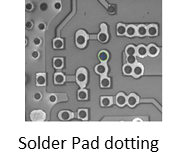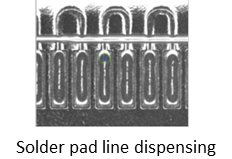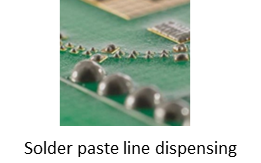
Used in the SMT industry for soldering electronic components such as surface mount resistors, capacitors, and ICs onto PCBs.
Solder paste is a novel soldering material that emerged alongside SMT. It is a paste-like mixture composed of solder powder, flux, and other additives such as surfactants and rheology modifiers.
Currently, the most common method for applying solder paste in the SMT industry is through stencil printing. With the gradual reduction in pad sizes, development of 3D product geometries and mixed technologies pushed the development of single point solder past dispensing.
The methods for solder paste dispensing include jetting, auger valve and time pressure where the last two utilize a dispense needle.
Time Pressure: Time Pressure is the simplest of all fluid dispensing that applies a pulse of air and sometimes vacuum to a syringe of fluid. The pulse of air will press fluid through the dispense tip to the product surface.
Jetting: Jetting is a non-contact dispensing method where solder paste is ejected to the substrate. Axxon Mycronic as developed solder jetting technology that can achieve dot diameters of approximately 0.5mm over a wide range of solder pastes.
Auger valve: Auger valves are a versatile dispense technology that use a controlled auger rotation to transfer fluid from a fluid reservoir (syringe, typically 10-30cc) through a dispense tip. Dispensing can be adjusted through parameters such as acceleration, deceleration, forward and reverse motion. Axxon's V-8000 series auger valves have a minimum dot diameter of around 0.15mm and a minimum line width of approximately 0.2mm.
Both syringe dispensing and auger valves utilize dispenes tips that can be customized for the process. Dispense tips vary in geometry, taper or straight tip, length, diameter and even materials. Dispensing height is a critical factor in repeatable dispensing with a dispense tip. Axxon's dispensing platforms are equipped with needle calibration so the system may locate the dispense tip after installation. Laser height surface detection is used to locate the dispense surface before the process begins. These two tools ensure consistent dispense results day-in-and-day-out.


